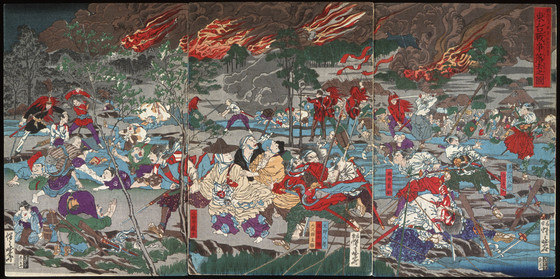Defeat at the Battle of Ueno, on the fifteenth day of the fifth month of Meiji 1.(1868)

Please log in to add this item to your gallery.
View comments
No comments have been posted yet.
Add a comment
Please log in to add comments.
Please log in to add tags.
* Nearly 20,000 images of artworks the museum believes to be in the public domain are available to download on this site.
Other images may be protected by copyright and other intellectual property rights.
By using any of these images you agree to LACMA's Terms of Use.
Defeat at the Battle of Ueno, on the fifteenth day of the fifth month of Meiji 1.(1868)
Alternate Title: Meiji gan tsuchinoe tatsu nen gogatsu jūgonichi Tōdai sensō rakukyo no zu
Japan, November, 1874Prints; woodblocks
Triptych; color woodblock prints
(a) Image: 14 x 9 3/8 in. (35.6 x 23.9 cm); Paper: 14 x 9 3/8 in. (35.6 x 23.9 cm); (b) Image: 14 x 9 3/8 in. (35.6 x 23.9 cm); Paper: 14 x 9 3/8 in. (35.6 x 23.9 cm); (c) Image: 14 x 9 3/8 in. (35.6 x 23.9 cm); Paper: 14 x 9 3/8 in. (35.6 x 23.9 cm)
Herbert R. Cole Collection (M.84.31.534a-c)
Not currently on public view


